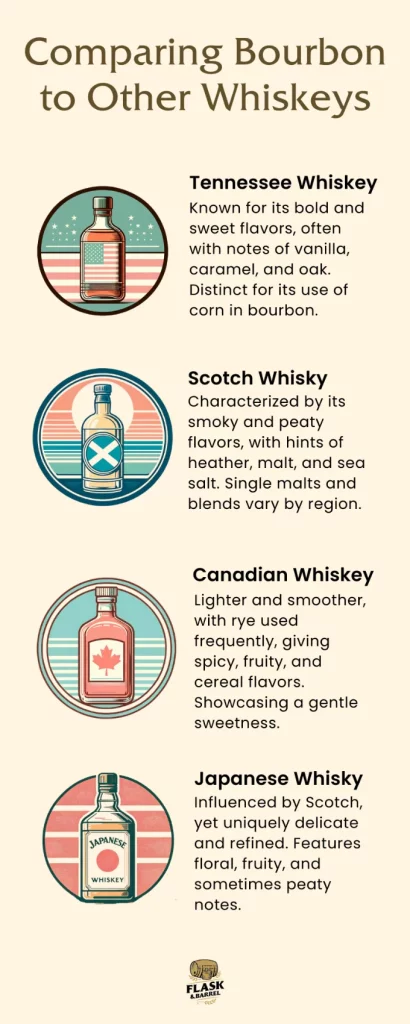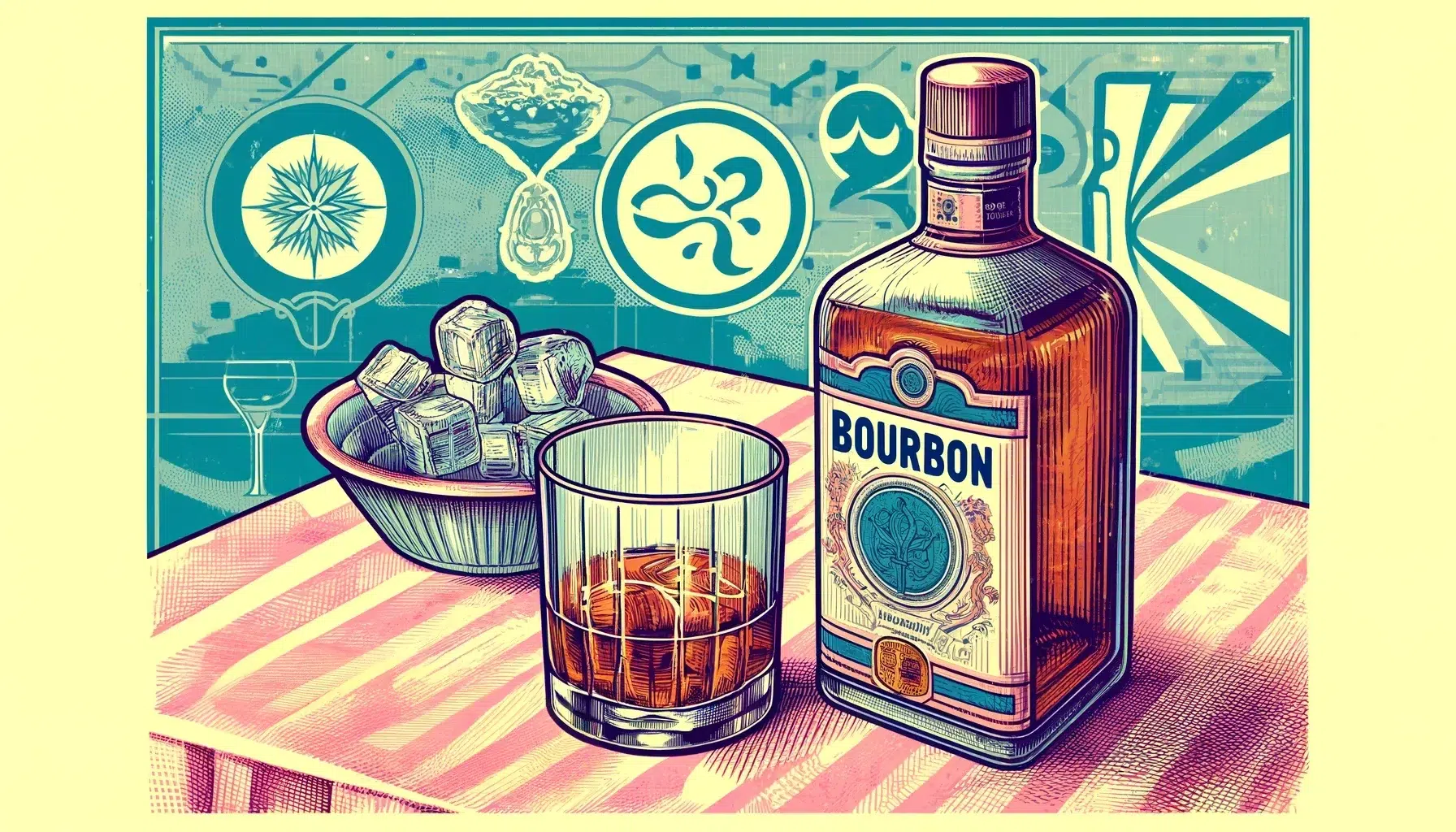Bourbon is a true American classic. It stands apart in from other contemporary whiskeys due to its unique production rules and rich flavor profiles.
Characterized by its sweetness stemming from the corn mash bill, and the complex notes from new charred oak barrel aging. Enthusiasts claim that Bourbon offers a depth that’s simply engaging than other spirits.
This article will delve into these facets in greater depth, providing a more comprehensive understanding of what makes bourbon a revered spirit across the globe.
Types of Bourbon
Bourbon, a quintessential American spirit, unfolds in a variety of types, each catering to diverse taste preferences and occasions. At the heart of bourbon’s diversity are four primary categories:

- Straight Bourbon offers a pure and unadulterated experience, aged for a minimum of two years without any added colors or flavors, showcasing the true essence of bourbon.
- Kentucky Bourbon, a geographical designation, is distilled and aged in Kentucky, benefiting from the state’s unique climate to develop its distinctive taste.
- Small Batch Bourbon is produced by blending a select number of barrels, aiming for a consistent character and high quality in each batch.
- Single Barrel Bourbon stands out for its uniqueness, with each barrel yielding a distinct flavor profile, making it a sought-after choice for connoisseurs.
These types represent the breadth and depth of bourbon’s rich heritage, each bringing its own narrative and sensory journey to enthusiasts around the globe.
Distinct Characteristics of Bourbon
Bourbon’s identity is firmly rooted in a blend of legal stipulations, distinctive flavor profiles, and meticulous production practices. Central to its definition, bourbon must be crafted within the United States, with a mash bill comprising at least 51% corn, and aged in new, charred oak barrels. This legal framework ensures each bottle of bourbon delivers a taste that is unmistakably rich and full-bodied.

The flavor of bourbon is a tapestry of complexity, weaving together sweet notes of vanilla and caramel with the robust warmth of spices. This spectrum is a direct result of its corn-rich composition and the transformative power of charred oak aging, which imparts depth and smoothness to the spirit. Moreover, the aging process, especially pronounced in Kentucky’s fluctuating climate, plays a pivotal role in bourbon’s maturation, allowing it to develop a nuanced character that is both bold and refined.
These defining characteristics not only underscore bourbon’s unique place in the world of spirits but also pay homage to its rich heritage and the artistry behind its creation.
The Rich Flavor Spectrum of Bourbon
Bourbon boasts a lavish flavor spectrum that is only fully appreciated when you drink via the whiskey tasting process. The inherent sweetness, with flavors of vanilla, caramel, and butterscotch, is expertly balanced by a spicy zest of cinnamon and nutmeg. This complexity is further deepened by the charred oak barrels, which contribute smoky and leathery undertones, offering a rich, multifaceted taste experience.
Influence of Grain Bill on Flavor
At the heart of bourbon’s distinctive taste is its grain bill, a critical determinant of its flavor profile. Predominantly crafted from corn, bourbon is naturally imbued with a sweet essence. The choice between rye or wheat as secondary grains introduces additional flavor layers; rye adds a peppery spice, elevating the spirit’s boldness, while wheat lends a softer, smoother finish.
Barley, though a minor component, plays an essential role in fermentation, subtly infusing the bourbon with nutty and bready nuances.
The Role of Aging in Flavor Development
The aging process is crucial for the development of bourbon’s flavor. Stored in new, charred oak barrels, bourbon absorbs the wood’s charred characteristics, undergoing a transformation that enriches it with a complex blend of flavors. The duration of aging, coupled with the storage climate—especially Kentucky’s fluctuating conditions—further molds its character.
Extended aging periods result in a smoother, more refined bourbon, characterized by a deep richness that is both potent and velvety.
Pairing Bourbon with Food
If you’re wondering how to properly appreciate your Bourbon, pairing bourbon with food can transform a meal into an exquisite culinary journey. The secret to a successful pairing is to align bourbon’s rich flavor spectrum—from sweet vanilla and caramel to spicy cinnamon—with complementary food profiles. Smoked meats and barbecue naturally complement bourbon’s smoky essence, while the spirit’s sweetness beautifully contrasts with the saltiness of aged cheeses or the richness of dark chocolate, enhancing the complexity of both the bourbon and the dish.

Even seafood, especially when grilled or slightly sweet, can offer a lighter, yet equally delightful counterpoint to bourbon’s robust character. Through thoughtful combinations, each pairing not only elevates the individual flavors but also turns dining into an immersive sensory exploration.
Which Bourbon Should You Try First?
Entering the world of bourbon presents an array of choices, each with its unique character and appeal. To ease this journey, selecting a bourbon that matches your flavor preference is key. For those inclined towards gentle and smooth experiences, a bourbon with a higher wheat content in the mash bill is advisable.
Conversely, if bold and spicy flavors captivate your palate, opt for bourbons with a greater rye presence. And for those who cherish sweet and rich undertones, bourbons that boast prominent caramel and vanilla notes are the perfect introduction. Starting with these focused recommendations allows for a more enjoyable exploration, guiding you towards discovering the bourbons that resonate most deeply with your personal taste.

For Those Seeking Gentle, Smooth Flavors
Individuals inclined towards a more subdued and velvety drinking experience will find solace in wheat-heavy bourbons. These spirits are marked by their smoothness, with understated flavors of vanilla and honey that caress the palate. Ideal for those new to bourbon or preferring a less intense flavor, these selections are best enjoyed neat or with a slight dilution, offering a welcoming introduction to the bourbon universe.
For Enthusiasts of Bold, Spicy Notes
Those with a palate craving intensity and spice will be drawn to bourbons with a significant rye component. These bourbons pack a punch, delivering a robust, spicy profile with layers of pepper, cinnamon, and cloves. Perfect for crafting complex cocktails, they imbue drinks with a depth and character that elevate the cocktail experience.
For Lovers of Sweet, Rich Profiles
For individuals who revel in sweetness and opulence, bourbons that exude caramel, toffee, and butterscotch flavors are a match made in heaven. Often resulting from extended aging periods, these bourbons draw an array of deep, rich flavors from the charred oak of their barrels. Serving as an ideal dessert companion, they offer a luscious, indulgent sipping experience that caters to the sweet palate.
Regulation Requirements Of Bourbon
Bourbon is distinguished by strict regulation requirements that define its production and ensure its unique identity among spirits. Key among these is the stipulation that bourbon must be produced in the United States, and its mash bill must consist of at least 51% corn, giving bourbon its signature sweetness. The distillation process is capped at 160 proof, and the spirit must be stored in new, charred oak barrels at no more than 125 proof for aging, which imparts the classic flavors of vanilla and caramel.
While bourbon has no minimum aging requirement, to qualify as straight bourbon, it must be aged for a minimum of two years. These regulatory measures not only preserve the quality and consistency of bourbon but also pay homage to its deep-rooted traditions.
History of Bourbon
The history of bourbon is deeply intertwined with the American narrative, originating in the late 18th century among the settlers of Kentucky. These early distillers leveraged the region’s plentiful corn crops, laying the groundwork for what would become a defining American spirit. Bourbon’s journey is marked by significant milestones, including the establishment of Bourbon County in Kentucky, which lent the spirit its name, and the 1964 Congressional Resolution that declared bourbon a distinctive product of the United States.
These pivotal moments have enshrined bourbon not just as a popular beverage but as an enduring symbol of American heritage and craftsmanship.
Key Historical Milestones and Notable Distilleries
Bourbon’s rich tapestry is adorned with key historical milestones and the legacy of notable distilleries that have sculpted its identity. The establishment of Bourbon County in Kentucky in 1785 marks a pivotal moment in bourbon’s inception, laying the groundwork for its development. The Bottled-in-Bond Act of 1897 was a landmark in bourbon history, setting stringent standards for its production and ensuring the spirit’s purity and quality.
The recognition of bourbon as a distinctive product of the United States by a Congressional resolution in the mid-20th century underscored its importance to American cultural heritage. Among the distilleries that have played a crucial role in bourbon’s evolution, Jim Beam, established in 1795, stands as a testament to enduring legacy and innovation. Maker’s Mark, renowned for its signature hand-dipped red wax seal, has become synonymous with quality and craftsmanship.
Buffalo Trace Distillery, with its deep historical roots, and Woodford Reserve, celebrated for its traditional distillation methods and scenic location, have both contributed significantly to the prestige and popularity of bourbon. These distilleries, along with others, have not only preserved the artisanal traditions of bourbon production but have also introduced innovations, ensuring bourbon remains a beloved spirit worldwide.
Comparing Bourbon To Other Whiskeys
Bourbon, with its rich heritage and distinctive character, occupies a special place in the whiskey world. It is set apart by strict production regulations, including a mash bill of at least 51% corn and aging in new, charred oak barrels, which imbue it with a unique sweetness and full-bodied flavor.
- Tennessee Whiskey, while sharing many similarities with bourbon, undergoes an additional charcoal mellowing process that lends it a smoother finish.
- Canadian Whisky is typically lighter and fruitier, characterized by its blend of various grain spirits, offering a more diverse flavor profile.
- Japanese Whisky is celebrated for its precision and balance, drawing inspiration from the Scotch tradition but distinguished by its subtle refinement.
- Scotch Whisky varies widely across its regions, from peaty and smoky to light and floral, reflecting the diverse production methods and environments of Scotland.
Each whiskey type presents its own unique narrative and sensory journey, showcasing the rich diversity of traditions and tastes across the globe.

Bourbon vs Tennessee Whiskey
Bourbon and Tennessee Whiskey, while cousins in the American whiskey family, diverge notably due to Tennessee Whiskey’s Lincoln County Process. This unique step involves filtering the spirit through sugar maple charcoal, lending Tennessee Whiskey a smoother and mellower taste compared to bourbon’s typically bolder and sweeter flavor profile.
Bourbon vs Canadian Whisky
In the comparison between bourbon and Canadian Whisky, the differences are marked by the variety of grains and blending practices. Canadian Whisky, known for its lighter, smoother taste, often blends multiple grain spirits, offering a subtle complexity. In contrast, bourbon’s depth and richness stem from its corn-dominant mash bill and new oak barrel aging, showcasing a more pronounced sweetness.
Bourbon vs Japanese Whisky
Bourbon and Japanese Whisky represent distinct traditions within the whiskey world. Japanese Whisky, with its Scotch-inspired heritage, is prized for its balance, subtlety, and elegance, often presenting a delicate complexity. Bourbon, on the other hand, is characterized by its robust, sweet, and full-bodied profile, a result of its specific grain requirements and aging process.
Bourbon vs Scotch Whisky
The distinction between bourbon and Scotch Whisky is rooted in geographical origin, ingredients, and aging processes. Scotch Whisky, especially Single Malt Scotch, offers a spectrum of flavors from peaty and smoky to light and floral, influenced by its malted barley base and used oak barrel aging. Bourbon’s signature sweetness and vanilla-caramel notes come from its corn-rich mash and new, charred oak barrels, highlighting the unique production methods that define each spirit’s character.

